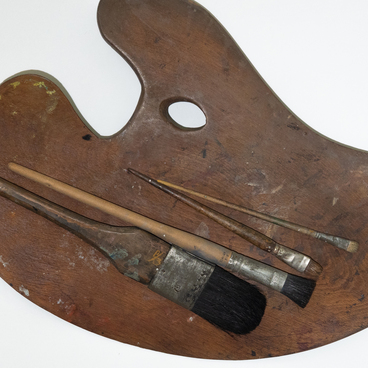The military uniform of the Russian army of the 19th century was sewn according to the fashion of those times. It was quite expensive, so the soldiers took good care of it. One of the important parts of the uniform was a shako helmet — a tall military headdress. It was worn by both officers and lower ranks.
The shako, housed in the museum, was made in 1826. It belonged to one of the lower ranks of the Imperial Guard Hussar Regiment. The headdress came from the Military Medical Museum, which is located in St. Petersburg.
The shako cap is shaped like a cone. It was made of leather and covered with a red woolen cloth. The left and right sides of the cap feature two vertical strips of golden lacing.
The top of the headdress is made of black patent leather. Along the upper edge, there is a shako lace with a hook to attach a pompom and a tassel to. On the hook, there is an oval cocarde made of light metal with the emperor Alexander’s monogram — “A I”. The 1828 guard’s coat of arms is attached to the front of the shako, and the scale-patterned chin strap is made of the yellow metal.
Shakos as an element of military uniforms appeared in the 18th century. In 1803, they were introduced in the hussar regiments of the guard and the army. This headgear was quite heavy and uncomfortable but it protected a soldier’s head from indirect saber blows.
In the first quarter of the 19th century, their appearance changed more than once. In 1809, the bottom of the shako was covered with leather, and a belt with a buckle was attached to the lower edge. In 1812, additional elements of the headdress — ears and neck protectors — were removed. Instead of ears protectors, the soldiers relied on a black cloth tape with a canvas lining. It was fastened under a chin with a leather button. They also used a special knitted patch made of undyed or black wool.
In 1817, the upper diameter of the shako cap was reduced. Nine years later, the headgear became taller. And a year later, the regiments of the guard and the army received coats of arms to attach to the shako. In April 1843, the shape of the headgear changed, and in 1845, the shako caps were replaced with bearskin hats.
In 1855, under Emperor Alexander II, the shako was reintroduced to the army. They existed until 1862 when they were replaced with kepis. In shape, they vaguely resembled shakos, but they were low with a flat comfortable visor. Chin straps were often attached to them.
The shako, housed in the museum, was made in 1826. It belonged to one of the lower ranks of the Imperial Guard Hussar Regiment. The headdress came from the Military Medical Museum, which is located in St. Petersburg.
The shako cap is shaped like a cone. It was made of leather and covered with a red woolen cloth. The left and right sides of the cap feature two vertical strips of golden lacing.
The top of the headdress is made of black patent leather. Along the upper edge, there is a shako lace with a hook to attach a pompom and a tassel to. On the hook, there is an oval cocarde made of light metal with the emperor Alexander’s monogram — “A I”. The 1828 guard’s coat of arms is attached to the front of the shako, and the scale-patterned chin strap is made of the yellow metal.
Shakos as an element of military uniforms appeared in the 18th century. In 1803, they were introduced in the hussar regiments of the guard and the army. This headgear was quite heavy and uncomfortable but it protected a soldier’s head from indirect saber blows.
In the first quarter of the 19th century, their appearance changed more than once. In 1809, the bottom of the shako was covered with leather, and a belt with a buckle was attached to the lower edge. In 1812, additional elements of the headdress — ears and neck protectors — were removed. Instead of ears protectors, the soldiers relied on a black cloth tape with a canvas lining. It was fastened under a chin with a leather button. They also used a special knitted patch made of undyed or black wool.
In 1817, the upper diameter of the shako cap was reduced. Nine years later, the headgear became taller. And a year later, the regiments of the guard and the army received coats of arms to attach to the shako. In April 1843, the shape of the headgear changed, and in 1845, the shako caps were replaced with bearskin hats.
In 1855, under Emperor Alexander II, the shako was reintroduced to the army. They existed until 1862 when they were replaced with kepis. In shape, they vaguely resembled shakos, but they were low with a flat comfortable visor. Chin straps were often attached to them.



